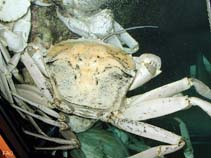Chaceon bicolor Manning & Holthuis, 1989
Pacific golden crab| Native range | All suitable habitat | Point map | Year 2050 |

|
| This map was computer-generated and has not yet been reviewed. |
| Chaceon bicolor AquaMaps Data sources: GBIF OBIS |
Classification / Names প্রচলিত নাম সমূহ | প্রতিনাম সমূহ | CoL | ITIS | WoRMS
Malacostraca | Decapoda | Geryonidae
Environment: milieu / climate zone / গভীরতার পরিসীমা / distribution range বাস্তুসংস্থান
; গভীরতার পরিসীমা 200 - 1620 m (সূত্র 343). Deep-water
Distribution দেশ সমূহ | এফ এ ও এলাকাসমূহ | বাস্তুতন্ত্র | দৃষ্টিগোচর | প্রচলন
Western Pacific.
Length at first maturity / আকৃতি / Weight / Age
পরিপক্কতা : Lm ? range ? - ? cm Max length : 18.0 cm CW পুরুষ/ লিঙ্গ অনিধর্ারিত ; (সূত্র 343); 15 cm CW (female)
Short description বহিঃ অঙ্গ সংস্থান
Life cycle and mating behavior পরিপক্কতা | প্রজনন | ডিম ছাড়া | Eggs | ডিম্বধারন ক্ষমতা | Larvae
Main reference
সূত্র সংখ্যা | সমম্বয়কারী | সহযোগী
Ng, P.K.L. 1998 Crabs. p. 1045-1155. In K.E. Carpenter and V.H. Niem (eds) FAO species identification guide for fishery purposes. The living marine resources of the Western Central Pacific. Volume 2. Cephalopods, crustaceans, holothurians and sharks. Rome, FAO. 1998. pp. 687-1396. (সূত্র 343)
IUCN Red List Status
(সূত্র 130435: Version 2025-1)
CITES status (সূত্র 108899)
CMS (সূত্র 116361)
Threat to humans
Human uses
মৎস্য: বাণিজ্যিক
| FishSource |
হাতিয়ার
আরো তথ্য
পথ্য উপাদান
খাদ্য গ্রহণ
শিকারী প্রাণী সমূহ
Max. ages / sizes
Length-weight rel.
Length-length rel.
Length-frequencies
Mass conversion
প্রাচুর্য
ইন্টারনেট সুত্র
BHL | BOLD Systems | CISTI | DiscoverLife | FAO(Publication : search) | Fishipedia | GenBank (genome, nucleotide) | GloBI | Gomexsi | Google Books | Google Scholar | Google | PubMed | জীবন বৃক্ষ | Wikipedia (Go, অনুসন্ধান ) | জুলজিকাল রেকর্ড



